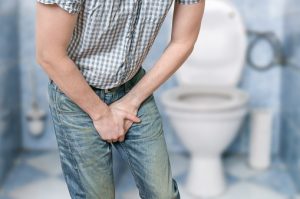 Urinary incontinence (UI) or loss of bladder control in men is not uncommon, but it can be treated once the cause is determined.
Urinary incontinence (UI) or loss of bladder control in men is not uncommon, but it can be treated once the cause is determined.
Uncontrollable urine in men or urinary incontinence occurs in eleven to 34 percent of older men, but it is not just an issue that impacts the aging. Younger men can also experience UI due to health problems. Urinary incontinence also happens to women, but the biggest issue with UI in men is that they are less likely to speak with their doctors about it. This means that the statistics could actually be much higher in men that the current numbers indicate. Discussing the problem is the first step to addressing the symptoms and finding a treatment.
Advertisement
Urinary incontinence often results in the accidental leakage of urine from the body, so it can be uncomfortable and inconvenient. A man can feel a strong, sudden need to urinate just before losing a large amount of urine. Doctors refer to this as “urgency incontinence”. For some people, this condition keeps them from enjoying certain activities, including sports and exercise. It can also cause a lot of emotional distress.
There are different types of urinary incontinence, so it is important to get a proper assessment from a doctor to determine what type you might have and how to go address it. The types of UI men experience include urgency incontinence, stress incontinence, functional incontinence, overflow UI, and transient UI.
We have already established what urgency incontinence is. Stress incontinence is leakage when a man coughs, laughs, sneezes, or overexerts himself. Functional incontinence is when physical or emotional disability prevents a person from getting to the washroom in time. Overflow incontinence occurs when the bladder fails to empty properly and later overflows, while transient incontinence is a temporary form of UI, normally an effect of certain medications.
Causes of urinary incontinence in men
Urinary incontinence in men takes place when the brain doesn’t send the right signals to the bladder. In many cases, the sphincters do not squeeze strongly enough. The bladder muscles may contract too much or they may not contract enough. Damage to the sphincter muscles or nerves that control the muscles can cause the problem.
A man might have a higher chance of developing UI for a number of reasons. Below is a list of factors that influence whether or not a man could develop urinary incontinence:
- Prostate cancer – treatment of surgery can lead to temporary or permanent UI
- Birth defects – issues with development of urinary tract
- Chronic coughing – increases pressure on bladder and pelvic floor muscles
- Benign prostatic hyperplasia – prostate is enlarged and can lead to UI
- Neurological problems – conditions that impact the brain and spine
- Obesity – extra weight can put pressure on bladder, resulting in the need to urinate before the bladder is full.
- Aging – bladder muscles weaken over time.
Getting treatment quickly is still important as the bladder tends to develop a functional memory. This means, the longer it doesn’t function properly, the harder it is to train it to go back to functioning the way it should.
Symptoms and risks for male incontinence
 The symptoms vary depending on what type of urinary incontinence you experience. Here is a look at the more common signs that you could be dealing with UI.
The symptoms vary depending on what type of urinary incontinence you experience. Here is a look at the more common signs that you could be dealing with UI.
- A sudden, urgent need to urinate
- A sudden leakage of urine
- The need to urinate frequently at night
- A urine stream that starts and stops when you urinate
- A weak urine stream
- The need to strain while urinating
- A sense that the bladder is not empty
- Leaking urine while sleeping
In addition to the risk factors mentioned above, there are other influences that can impact a man’s chances of experiencing urinary incontinence. For example, lifestyle choices can contribute to UI. We already mentioned obesity, but smoking tobacco has also been linked to an increased risk of urinary incontinence. Caffeinated and carbonated drinks, as well as alcohol, have also been associated with a higher incidence of UI. Men also have to be careful about diuretics or medicines that relax the bladder, such as anticholinergics and antidepressants. Other prescriptions, like sedatives and calcium channel blockers, have been associated with UI, and so have non-prescription diet, allergy, and cold medicines.
Certain diseases and health conditions put men at a higher risk of urinary incontinence, including the following:
- Bladder cancer
- Alzheimer’s disease
- Parkinson’s disease
- Stroke
- Diabetes
- Multiple sclerosis
- Chronic bronchitis
- Interstitial cystitis
- Depression
Treatment and diagnosis options for male incontinence
Urologists specialize in the diagnosis and treatment of urinary incontinence. They will take a full medical history and conduct a physical exam. A urine sample as well as a blood sample will likely be taken. The blood sample can tell a lot about a person’s kidney function. Blood samples can also assess protein produced by the prostate cells. This protein can be higher in men who have prostate cancer. Something called urodynamic testing may also be conducted. This testing includes a variety of procedures that can tell how well the bladder stores and releases urine.
The urologist may instruct a patient to keep a bladder diary. This is when you record the amount of liquid you drink, how many times you urinate, how often you leak, whether you had strong urges to go before leaking, and what you were doing when leaking occurred. This information can help the doctor pinpoint the type of UI you have.
Male urinary incontinence treatment can involve a number of different approaches. Again, depending on the type and cause, you will likely be treated with one or a combination of the following approaches:
- Lifestyle adjustments
- Bladder training
- Pelvic exercises
- Electric nerve stimulation
- Urgency suppression
- Bulking agents
- Medications
- Surgery
Male incontinence treatment and bladder training simply means you have to change your urination habits to lower the number of UI incidents. For example, the doctor might suggest the man use the washroom at certain regular scheduled times only. The length of time between trips to the washroom is extended to help train the bladder to be able to hold more urine. Urgency suppression is a way to train the bladder to maintain control so you don’t have to worry about finding a washroom. One way to do this is by finding distractions to keep your mind off the urge to urinate.
Surgery to treat male urinary incontinence is a last resort. It can involve using the artificial urinary sphincter (AUS) and the male sling. The AUS is an implanted device that keeps the urethra closed until the man is ready to urinate. The sling is a procedure whereby a surgeon secures tissue or mesh around the pelvic bones, thus lifting and compressing the urethra to provide better control over urination.
Advertisement
The prospect of surgery sounds scary. However, it is important to know that in the majority of situations, male incontinence exercises as well as lifestyle adjustments are the main remedy that helps people struggling with UI. Which means drastic measures like surgery are never required.
When to call a doctor for urinary incontinence in men
 For some men, urinary incontinence can be a minor inconvenience, but for others it can be severe and life changing. If you are experiencing a lot of problems with UI, such as weakness or numbness in your buttocks, legs, and feet, or if you get a fever, chills, and belly pain, you should see a doctor. Blood in the urine or burning with urination could also be a sign of a medical issue. Male incontinence at night, especially leakage while sleeping, needs to be addressed by a doctor.
For some men, urinary incontinence can be a minor inconvenience, but for others it can be severe and life changing. If you are experiencing a lot of problems with UI, such as weakness or numbness in your buttocks, legs, and feet, or if you get a fever, chills, and belly pain, you should see a doctor. Blood in the urine or burning with urination could also be a sign of a medical issue. Male incontinence at night, especially leakage while sleeping, needs to be addressed by a doctor.
While bringing urinary incontinence up with a doctor may seem embarrassing, just remember that they hear about it all the time from men. Also, the sooner you bring it up, the better chance you have of finding a proper treatment so you can resume normal living.
